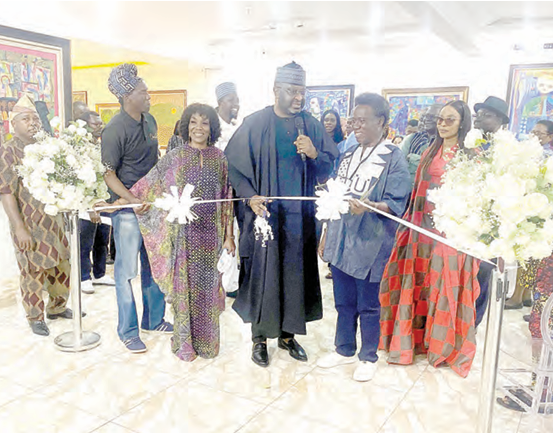Last Sunday, Orisun Gallery exhibited ‘Hieroglyphics of Womanhood’, a solo exhibition of international award-winning veteran artist, Chief Tola Wewe.
Featuring 24 art pieces, 22 by the artist, and two from his female counterpart, Nike Okundaye-Davies, the exhibition is an array of colourful, monochromatic and multi-media canvases, depicting women in variant traditional African abstract and semi-abstract contemporary images.
These images, viewers, are driven to ponder in a bid to decipher their meanings. Has the artist finally cracked the mystery that is woman and womanhood?
In a world, where one thirds of its continents have politicized the meaning of woman, ‘Hieroglyphics of Womanhood’ is comforting to see.
One sees nudity without vulgarity, and expression without denigration of the subject addressed. Because traditionally speaking, African art – sculpture in particular – has always featured women unclad, and it was neither a thing of sexual objectification or a shaming of women, rather as an icon of respect and celebration.
Similarly, in traditional Africa culture, women play prominent roles in the society – both as healers and performers at festivals. They are also rearers of children and makers of homes.
As Wewe said, “without a woman, they can be no man. Without woman they can’t be a family, and without women they can’t be a society.”
It is the usefulness and prominence of women (physically or spiritually) not necessarily the lifespan of womanhood – from infancy to puberty, sexual maturation to climacteric and post-climacteric years, that the artist explores.
“All I wanted was that whatever the impression I have, I wanted to express myself using images of women,” said Chief Wewe.
While he may not have been inspired by any significant structural, social or moral changes in womanhood over the decades of work depicting women (2009 – 2024) spanned by the exhibition, ‘Hieroglyphics of Womanhood’ explored different roles and positions of women in the African society (the Yoruba culture in particular); the spiritual significance of their positions, while paying homage to their unrelenting resilience.
Speaking of the exhibition, Executive Director, Orisun Gallery, Dr Adebola Adetunmbi said it is the ‘artist’s attempt and artistic representation of what womanhood is’, ‘an expression of the essence of womanhood’.
“A famous philosopher once said, “to know a woman is to understand the meaning of mystery”. Women are the most mysterious beings. The depth and complexity of what and who we are takes a lifetime to understand,” said Adetunmbi.
‘Hieroglyphics of Womanhood’ falls under one of Orisun Gallery’s major programmes – showcasing works of master Nigerian artistes – with the first in the planned series featuring multi-disciplinary artist, Bruce Onobrakpeya last year.
“In the near future, we also hope to host Chief Jimoh Braimoh, Chief Muraino Oyelani and others,” said the ED.
While the gallery holds occasional events and exhibitions to promote and build the capacity of young and upcoming artists, Adetunmbi said, Nigerian government should sponsor capacity building, exhibitions of works by young artists both locally and internationally.
We’ve got the edge. Get real-time reports, breaking scoops, and exclusive angles delivered straight to your phone. Don’t settle for stale news. Join LEADERSHIP NEWS on WhatsApp for 24/7 updates →
Join Our WhatsApp Channel










